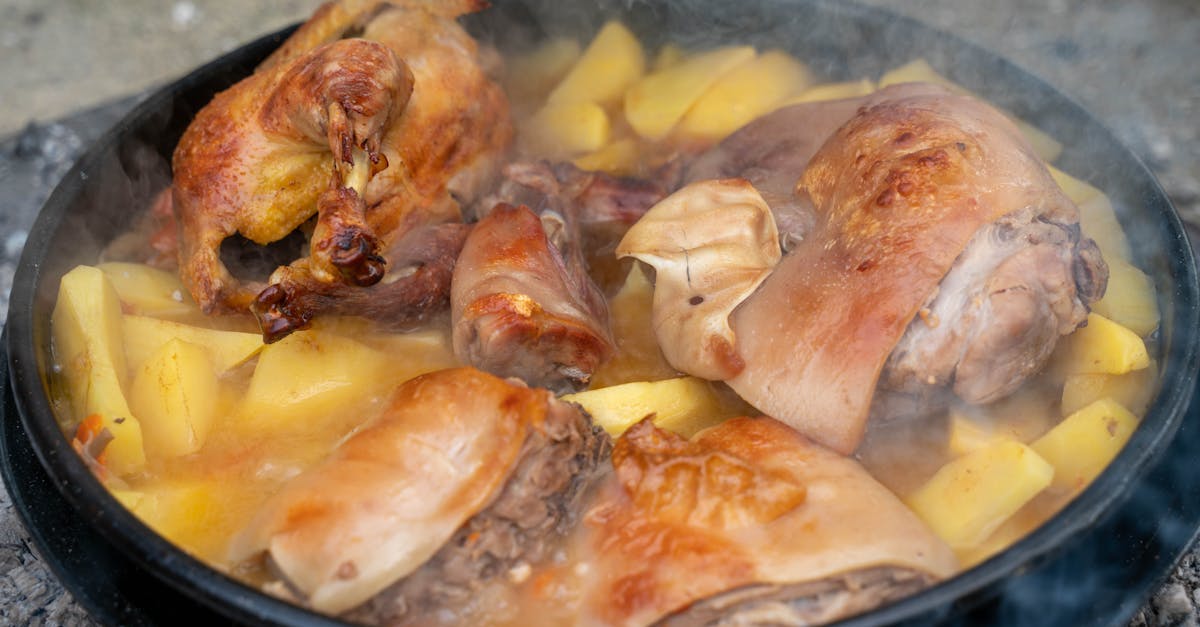Originally posted on March 10, 2025 @ 10:52 pm
When it comes to cooking, we often find ourselves experimenting with ingredients to create delicious meals that cater to our dietary preferences. One common question that pops up is whether we can swap out pork for seitan in a casserole. As more people embrace plant-based diets, finding satisfying alternatives becomes essential.
Understanding Seitan
Seitan, a popular meat alternative, offers a versatile option for those seeking plant-based ingredients. Often referred to as “wheat meat,” seitan provides both texture and flavor suitable for various dishes, including casseroles.
What Is Seitan?
Seitan is a protein-rich food made from gluten, the protein component found in wheat. Its chewy texture makes it an excellent substitute in many recipes where meat is traditionally used.
- Origin: Seitan has roots in Asian cuisine, particularly in Chinese Buddhist cooking, dating back centuries.
- Preparation: We create seitan by washing wheat flour dough with water to remove the starch, leaving behind a sticky mass of gluten.
- Forms: Seitan comes in several forms, including:
- Fresh: Often sold in bulk or vacuum-sealed.
- Dried: Requires rehydration before use.
- Pre-seasoned: Ready-to-eat options available in stores.
Nutritional Profile of Seitan
Seitan boasts a compelling nutritional profile that contributes to its popularity among plant-based eaters.
| Nutrient | Amount per 100g |
|---|---|
| Protein | 25g |
| Carbohydrates | 14g |
| Fat | 1.9g |
| Fiber | 2g |
| Calories | 143 kcal |
Benefits:
- High Protein Content: For those seeking to maintain protein intake without meat, seitan provides an excellent source, similar to pork.
- Low in Fat: It contains minimal fat, making it a leaner option for casseroles.
- Versatile Flavor Absorption: Seitan easily absorbs flavors from marinades or sauces, enhancing the overall taste of dishes.
Quote: “Seitan’s texture and ability to mimic meat make it a widely accepted choice for those on a plant-based diet.”
Seitan serves as an effective substitute for pork in casseroles, balancing both texture and nutritional needs for those looking to explore plant-based cooking.
Comparing Pork and Seitan
We’ll explore the key differences between pork and seitan, focusing on flavor and texture to understand how substituting one for the other affects casserole dishes.
Flavor Differences
When considering flavor profiles, pork has a distinct taste that varies depending on the cut and preparation method. Often described as rich and savory, it pairs well with various seasonings.
| Pork Flavor Profile | Seitan Flavor Profile |
|---|---|
| Rich | Mild |
| Savory | Versatile |
| Smoky (if smoked) | Absorbs surrounding flavors |
Seitan, on the other hand, is known for its mild flavor, which becomes a blank canvas for marinades and spices. As we integrate seitan into our casseroles, it readily absorbs flavors during cooking, enhancing the overall taste. Many cooks report that seitan works well when combined with bold spices, sauces, or broths, allowing us to control the flavor outcome.
“Seitan can be a game-changer for those wanting to explore new flavors in traditional dishes.”
Texture Considerations
In terms of texture, pork offers a varied experience based on the cut, often incorporating tenderness with marbled fat. Here’s a comparison to visualize their textural differences:
| Pork Texture | Seitan Texture |
|---|---|
| Tender (depending on cut) | Chewy and dense |
| Juicy | Firm and elastic |
| Succulent | Absorbs liquid (with cooking) |
Seitan mimics the chewier and denser aspects of pork remarkably well. With its elasticity, seitan holds up in casseroles, adding a hearty bite. While it may lack the juiciness of a well-cooked pork dish, we can compensate for this by incorporating moist ingredients such as sauces or broths, which enhances the overall dish.
Using seitan instead of pork in casseroles provides a satisfying texture and allows for a versatile flavor adaptation, catering to plant-based preferences without compromising on the essence of the dish.
Cooking with Seitan
Seitan stands as an excellent alternative to pork in casseroles. Its unique texture and flavor absorption abilities enhance the dish while maintaining a satisfying eating experience.
Best Practices for Substituting Seitan in Casseroles
We recommend the following best practices when using seitan in casserole recipes:
- Choose the Right Form
Select from fresh, dried, or pre-seasoned versions of seitan based on your recipe requirements. Fresh seitan works well for casseroles needing more moisture, while dried seitan may require rehydration.
- Marinate for Flavor
Marinating seitan can elevate its taste. Use soy sauce, garlic, or your favorite spices for added depth. Aiming for at least 30 minutes of marination maximizes flavor absorption.
- Adjust Portions
Replace pork with an equal weight of seitan, generally 1 cup of coarsely chopped seitan for 1 cup of pork. Adjust according to personal preference and desired texture.
- Enhance Texture
To mimic pork’s tenderness, incorporate moist ingredients like broths and sauces. Combining seitan with vegetables also enhances the overall texture and flavor profile.
Cooking Times and Methods
Cooking methods and times for casseroles can vary significantly when using seitan. Here’s a helpful breakdown:
| Cooking Method | Recommended Time | Tips |
|---|---|---|
| Baking | 30-45 minutes | Ensure seitan is heated thoroughly to absorb flavors. |
| Simmering | 20-25 minutes | Allows seitan to soak up surrounding flavors. |
| Sautéing | 5-10 minutes | Quick and great for browning before mixing into casseroles. |
| Pressure Cooking | 10-15 minutes | Maintains moisture and enhances flavor absorption. |
We suggest seasoning seitan while cooking, as it enhances its flavor profile. “Seitan’s versatility allows it to shine in any dish,” says chef Elena Smith, emphasizing the effectiveness of seitan as a meat alternative.
By following these best practices and cooking tips, we can create delicious, satisfying casseroles that stand up to traditional recipes while catering to plant-based diets.
Recipes Featuring Seitan in Casserole
We explore various recipes that highlight the versatility of seitan in casseroles, perfectly suited for those transitioning to plant-based meals. Below, we detail some classic casserole recipes and creative variations, along with tips to enhance every dish.
Classic Casserole Recipes with Seitan
- Seitan Shepherd’s Pie
Layers of savory seitan mixed with vegetables, topped with creamy mashed potatoes, create this comforting dish. Bake until golden for a hearty meal.
- Cheesy Seitan Enchilada Casserole
Combine seitan, corn tortillas, enchilada sauce, and cheese for a spicy twist. Bake and serve it with fresh cilantro for a flavorful experience.
| Ingredients | Quantity |
|---|---|
| Seitan | 300g |
| Mashed potatoes | 500g |
| Mixed veggies (carrots, peas) | 200g |
| Enchilada sauce | 400ml |
| Corn tortillas | 8 pieces |
| Cheese (dairy or vegan) | 200g |
“Using seitan in traditional dishes provides a satisfying texture without sacrificing flavor.”
- Seitan and Mushroom Stroganoff Casserole
A rich, creamy mushroom sauce mixed with tender seitan served over egg noodles or rice makes this casserole a crowd-pleaser.
Creative Variations to Try
- Buffalo Seitan Casserole
Toss baked seitan in buffalo sauce and layer it with quinoa and broccoli. Top with almond or vegan cheese and bake until bubbly.
- Mediterranean Seitan Casserole
Combine seitan with roasted vegetables, olives, and feta cheese. Serve it with a drizzle of olive oil and balsamic reduction for a savory explosion.
- Tex-Mex Seitan Rice Bake
Mix seitan with brown rice, black beans, and taco seasoning for a vibrant, spicy casserole topped with avocado and fresh lime juice.
| Casserole Variation | Key Ingredients |
|---|---|
| Buffalo Seitan Casserole | Buffalo sauce, quinoa, broccoli |
| Mediterranean Seitan Casserole | Olives, roasted vegetables, feta |
| Tex-Mex Seitan Rice Bake | Brown rice, black beans, taco spices |
“Exploring different cuisines with seitan opens up endless possibilities in casserole dishes.”
Conclusion
Substituting pork with seitan in casseroles opens up a world of delicious possibilities for our plant-based meals. We can enjoy the satisfying texture and versatility of seitan while embracing a healthier lifestyle.
By experimenting with marinades and seasonings, we can create flavorful dishes that rival traditional recipes. Whether we’re whipping up a comforting Shepherd’s Pie or a zesty Tex-Mex bake, seitan proves to be a fantastic alternative that doesn’t compromise on taste.
So let’s dive into our kitchens and get creative with seitan. It’s time to enjoy the benefits of plant-based cooking while savoring every bite!


